Subaqueous Topographic Deformation in Abandoned Delta Lobes—A Case Study in the Yellow River Delta, China
Abstract
1. Introduction
2. Study Area
3. Materials and Methods
3.1. Historical Bathymetric Data and Current Microtopography Survey
3.2. Seabed Sediment Sampling and Analysis
3.3. Quantification of Seabed Deformation
4. Results
4.1. Seabed Deformation
4.2. Sediment Characteristics
4.3. Seabed Surface Microtopography Features in September 2019
5. Discussion
6. Conclusions
Author Contributions
Funding
Data Availability Statement
Acknowledgments
Conflicts of Interest
References
- Best, J. Anthropogenic stresses on the world big rivers. Nat. Geosci. 2019, 12, 7–21. [Google Scholar] [CrossRef]
- Gernaat, D.E.; Bogaart, P.W.; Vuuren, D.P.V.; Biemans, H.; Niessink, R. High-resolution assessment of global technical and economic hydropower potential. Nat. Energy 2017, 2, 821–828. [Google Scholar] [CrossRef]
- Syvitski, J.P.; Vorosmarty, C.J.; Kettner, A.J.; Green, P. Impact of humans on the flux of terrestrial sediment to the global coastal ocean. Science 2005, 308, 376–380. [Google Scholar] [CrossRef]
- Guo, X.; Fan, D.; Zheng, S.; Wang, H.; Zhao, B.; Qin, C. Revisited sediment budget with latest bathymetric data in the highly altered Yangtze (Changjiang) Estuary. Geomorphology 2021, 391, 107873. [Google Scholar] [CrossRef]
- Bussi, G.; Darby, S.E.; Whitehead, P.G.; Jin, L.; Dadson, S.J.; Voepel, H.E.; Nicholas, A. Impact of dams and climate change on suspended sediment flux to the Mekong delta. Sci. Total Environ. 2021, 755, 142468. [Google Scholar] [CrossRef] [PubMed]
- Ve, N.D.; Fan, D.; Van Vuong, B.; Lan, T.D. Sediment budget and morphological change in the Red River Delta under increasing human interferences. Mari. Geol. 2021, 431, 106379. [Google Scholar] [CrossRef]
- Stone, G.W.; Grymes, J.M.; Dingler, J.R.; Pepper, D.A. Overview and significance of hurricanes on the Louisiana coast, USA. J. Coast. Res. 1997, 13, 656–669. [Google Scholar]
- Rosen, T.; Xu, Y.J. Recent decadal growth of the Atchafalaya River Delta complex: Effects of variable riverine sediment input and vegetation succession. Geomorphology 2013, 194, 108–120. [Google Scholar] [CrossRef]
- Zheng, S.; Cheng, H.; Shi, S.; Xu, W.; Zhou, Q.; Jiang, Y.; Zhou, F.; Cao, M. Impact of anthropogenic drivers on subaqueous topographical change in the Datong to Xuliujing reach of the Yangtze River. Sci. China Earth Sci. 2018, 61, 940–950. [Google Scholar] [CrossRef]
- Kuehl, S.A.; Williams, J.; Liu, J.P.; Harris, C.; Aung, D.W.; Tarpley, D.; Aye, Y.Y. Sediment dispersal and accumulation off the Ayeyarwady Delta-Tectonic and oceanographic controls. Mari. Geol. 2019, 417, 106000. [Google Scholar] [CrossRef]
- Zhang, W.; Xu, Y.J.; Guo, L.; Lam, N.S.N.; Xu, K.; Yang, S.; Yao, Q.; Liu, K.B. Comparing the Yangtze and Mississippi River Deltas in the light of coupled natural-human dynamics: Lessons learned and implications for management. Geomorphology 2022, 399, 108075. [Google Scholar] [CrossRef]
- Muis, S.; Verlaan, M.; Winsemius, H.C.; Aerts, J.C.; Ward, P.J. A global reanalysis of storm surges and extreme sea levels. Nat. Commun. 2016, 7, 11969. [Google Scholar] [CrossRef]
- Wang, B.; Xu, Y.J.; Xu, W.; Cheng, H.; Chen, Z.; Zhang, W. Riverbed changes of the Uppermost Atchafalaya River, USA-a case study of channel dynamics in large man-controlled alluvial river confluences. Water 2020, 12, 2139. [Google Scholar] [CrossRef]
- Cheng, H.Q.; Chen, J.Y.; Chen, Z.J.; Ruan, R.L.; Xu, G.Q.; Zeng, G.; Wang, H.M. Mapping Sea Level Rise Behavior in an Estuarine Delta System: A Case Study along the Shanghai Coast. Engineering 2018, 4, 156–163. [Google Scholar] [CrossRef]
- Yuan, B.; Sun, J.; Lin, B.; Zhang, F. Long-term morphodynamics of a large estuary subject to decreasing sediment supply and sea level rise. Glob. Planet Chang. 2020, 191, 103212. [Google Scholar] [CrossRef]
- Li, P.; Chen, S.; Ji, H.; Ke, Y.; Fu, Y. Combining Landsat-8 and Sentinel-2 to investigate seasonal changes of suspended particulate matter off the abandoned distributary mouths of Yellow River Delta. Mari. Geol. 2021, 441, 106622. [Google Scholar] [CrossRef]
- Zhu, Q.; Li, P.; Li, Z.; Pu, S.; Wu, X.; Bi, N.; Wang, H. Spatiotemporal Changes of Coastline over the Yellow River Delta in the Previous 40 Years with Optical and SAR Remote Sensing. Remote Sens. 2021, 13, 1940. [Google Scholar] [CrossRef]
- Nienhuis, J.H.; Ashton, A.D.; Edmonds, D.A.; Hoitink, A.J.F.; Kettner, A.J.; Rowland, J.C.; Törnqvist, T.E. Global-scale human impact on delta morphology has led to net land area gain. Nature 2020, 577, 514–518. [Google Scholar] [CrossRef] [PubMed]
- Walling, D.E. Human impact on land-ocean sediment transfer by the world’s rivers. Geomorphology 2006, 79, 192–216. [Google Scholar] [CrossRef]
- Meade, R.H.; Moody, J.A. Causes for the decline of suspended-sediment discharge in the Mississippi River system, 1940–2007. Hydrol. Process. 2010, 24, 35–49. [Google Scholar] [CrossRef]
- Stanley, D.J.; Warne, A.G. Nile delta: Recent geological evolution and human impact. Science 1993, 260, 628. [Google Scholar] [CrossRef]
- Jiang, C.; Chen, S.; Pan, S.; Fan, Y.; Ji, H. Geomorphic evolution of the Yellow River Delta: Quantification of basin-scale natural and anthropogenic impacts. CATENA 2018, 163, 361–377. [Google Scholar] [CrossRef]
- Wang, H.; Bi, N.; Saito, Y.; Wang, Y.; Sun, X.; Zhang, J.; Yang, Z. Recent changes in sediment delivery by the Huanghe (Yellow River) to the sea: Causes and environmental implications in its estuary. J. Hydrol. 2010, 391, 302–313. [Google Scholar] [CrossRef]
- Miao, C.; Ni, J.; Borthwick, A.G. Recent changes of water discharge and sediment load in the Yellow River basin, China. Prog. Phys. Geog. 2010, 34, 541–561. [Google Scholar] [CrossRef]
- Wang, G.; Li, P.; Li, Z.; Ding, D.; Qiao, L.; Xu, J.; Wang, H. Coastal Dam Inundation Assessment for the Yellow River Delta: Measurements, Analysis and Scenario. Remote Sens. 2020, 12, 3658. [Google Scholar] [CrossRef]
- Ji, H.; Chen, S.; Pan, S.; Xu, C.; Tian, Y.; Li, P.; Liu, Q.; Chen, L. Fluvial sediment source to sink transfer at the Yellow River Delta: Quantifications, causes, and environmental impacts. J. Hydrol. 2022, 608, 127622. [Google Scholar] [CrossRef]
- Ji, H.; Pan, S.; Chen, S. Impact of river discharge on hydrodynamics and sedimentary processes at Yellow River Delta. Mari. Geol. 2020, 425, 106210. [Google Scholar] [CrossRef]
- Fan, Y.; Chen, S.; Zhao, B.; Pan, S.; Jiang, C.; Ji, H. Shoreline dynamics of the active Yellow River delta since the implementation of Water-Sediment Regulation Scheme: A remote-sensing and statistics-based approach. Estuar. Coast. Shelf S. 2018, 200, 406–419. [Google Scholar] [CrossRef]
- Qiao, S.; Shi, X.; Saito, Y.; Li, X.; Yu, Y.; Bai, Y.; Yang, G. Sedimentary records of natural and artificial Huanghe (Yellow River) channel shifts during the Holocene in the southern Bohai Sea. Cont. Shelf Res. 2011, 31, 1336–1342. [Google Scholar] [CrossRef]
- Niu, J.; Xu, J.; Li, G.; Qiao, L. Swell-dominated sediment re-suspension in a silty coastal seabed. Estuar. Coast. Shelf S. 2020, 242, 106845. [Google Scholar] [CrossRef]
- Ji, H.; Chen, S.; Jiang, C.; Fan, Y.; Fu, Y.; Li, P.; Liu, F. Damming-Induced Hydrogeomorphic Transition in Downstream Channel and Delta: A Case Study of the Yellow River, China. Water 2022, 14, 2079. [Google Scholar] [CrossRef]
- Yu, J.; Fu, Y.; Li, Y.; Han, G.; Wang, Y.; Zhou, D.; Meixner, F.X. Effects of water discharge and sediment load on evolution of modern Yellow River Delta, China, over the period from 1976 to 2009. Biogeosciences 2011, 8, 2427–2435. [Google Scholar] [CrossRef]
- Jia, Y.; Zeng, J.; Yue, Z.; Liu, X.; Shan, H. Tidal flat erosion of the Huanghe River Delta due to local changes in hydrodynamic conditions. Acta Oceanol. Sin. 2014, 33, 116–124. [Google Scholar] [CrossRef]
- Bi, N.; Wang, H.; Wu, X.; Saito, Y.; Xu, C.; Yang, Z. Phase change in evolution of the modern Huanghe (Yellow River) Delta: Process, pattern, and mechanisms. Mari. Geol. 2021, 437, 106516. [Google Scholar] [CrossRef]
- Zheng, S.; Cheng, H.; Lv, J.; Li, Z.; Zhou, L. Morphological evolution of estuarine channels influenced by multiple anthropogenic stresses: A case study of the North Channel, Yangtze estuary, China. Estuar. Coast. Shelf S. 2021, 249, 107075. [Google Scholar] [CrossRef]
- Dai, Z.; Liu, J.T.; Fu, G.; Xie, H. A thirteen-year record of bathymetric changes in the North Passage, Changjiang (Yangtze) estuary. Geomorphology 2013, 187, 101–107. [Google Scholar] [CrossRef]
- Xu, Y.J.; Wang, B.; Xu, W.; Tang, M.; Tsai, F.T.C.; Smith, L.C. Four-decades of bed elevation changes in the heavily regulated upper Atchafalaya River, Louisiana, USA. Geomorphology 2021, 386, 107748. [Google Scholar] [CrossRef]
- Yang, S.L.; Milliman, J.D.; Li, P.; Xu, K. 50,000 dams later: Erosion of the Yangtze River and its delta. Glob. Planet Chang. 2011, 75, 14–20. [Google Scholar] [CrossRef]
- Zheng, S.; Luo, H.; Zhang, J.; Cheng, H.; Li, Z.; Ma, Y.; Liu, E. Sediment budget and riverbed deformation in the uppermost part of the lower Yangtze River, China. Int. J. Sediment Res. 2022, 37, 484–492. [Google Scholar] [CrossRef]
- Gao, S. Modeling the growth limit of the Changjiang Delta. Geomorphology 2007, 85, 225–236. [Google Scholar] [CrossRef]
- Wang, H.; Yang, Z.; Saito, Y.; Liu, J.P.; Sun, X.; Wang, Y. Stepwise decreases of the Huanghe (Yellow River) sediment load (1950–2005): Impacts of climate change and human activities. Glob. Planet Chang. 2007, 57, 331–354. [Google Scholar] [CrossRef]
- Li, J.; Xia, J.; Ji, Q. Rapid and long-distance channel incision in the Lower Yellow River owing to upstream damming. CATENA 2021, 196, 104943. [Google Scholar] [CrossRef]
- Yonggui, Y.; Xuefa, S.; Houjie, W.; Chengkun, Y.; Shenliang, C.; Yanguang, L.; Shuqing, Q. Effects of dams on water and sediment delivery to the sea by the Huanghe (Yellow River): The special role of Water-Sediment Modulation. Anthropocene 2013, 3, 72–82. [Google Scholar] [CrossRef]
- Fan, D.; Wu, Y.; Zhang, Y.; Burr, G.; Huo, M.; Li, J. South Flank of the Yangtze Delta: Past, present, and future. Mari. Geol. 2017, 392, 78–93. [Google Scholar] [CrossRef]
- Hoitink AJ, F.; Wang, Z.B.; Vermeulen, B.; Huismans, Y.; Kstner, K. Tidal controls on river delta morphology. Nat. Geosci. 2017, 10, 637–645. [Google Scholar] [CrossRef]
- Kong, D.; Miao, C.; Borthwick, A.G.; Duan, Q.; Liu, H.; Sun, Q.; Gong, W. Evolution of the Yellow River Delta and its relationship with runoff and sediment load from 1983 to 2011. J. Hydrol. 2015, 520, 157–167. [Google Scholar] [CrossRef]
- Wu, Z.; Milliman, J.D.; Zhao, D.; Cao, Z.; Zhou, J.; Zhou, C. Geomorphologic changes in the lower Pearl River Delta, 1850–2015, largely due to human activity. Geomorphology 2018, 314, 42–54. [Google Scholar] [CrossRef]
- Wu, X.; Bi, N.; Syvitski, J.; Saito, Y.; Xu, J.; Nittrouer, J.A.; Wang, H. Can Reservoir Regulation Along the Yellow River Be a Sustainable Way to Save a Sinking Delta? Earths Future 2020, 8, e2020EF001587. [Google Scholar] [CrossRef]
- Xie, W.; Wang, X.; Guo, L.; He, Q.; Dou, S.; Yu, X. Impacts of a storm on the erosion process of a tidal wetland in the Yellow River Delta. CATENA 2021, 205, 105461. [Google Scholar] [CrossRef]
- Wang, H.; Wu, X.; Bi, N.; Li, S.; Yuan, P.; Wang, A.; Nittrouer, J. Impacts of the dam-orientated water-sediment regulation scheme on the lower reaches and delta of the Yellow River (Huanghe): A review. Glob. Planet Chang. 2017, 157, 93–113. [Google Scholar] [CrossRef]
- Liu, L.; Wang, H.; Yang, Z.; Fan, Y.; Wu, X.; Hu, L.; Bi, N. Coarsening of sediments from the Huanghe (Yellow River) delta-coast and its environmental implications. Geomorphology 2022, 401, 108105. [Google Scholar] [CrossRef]
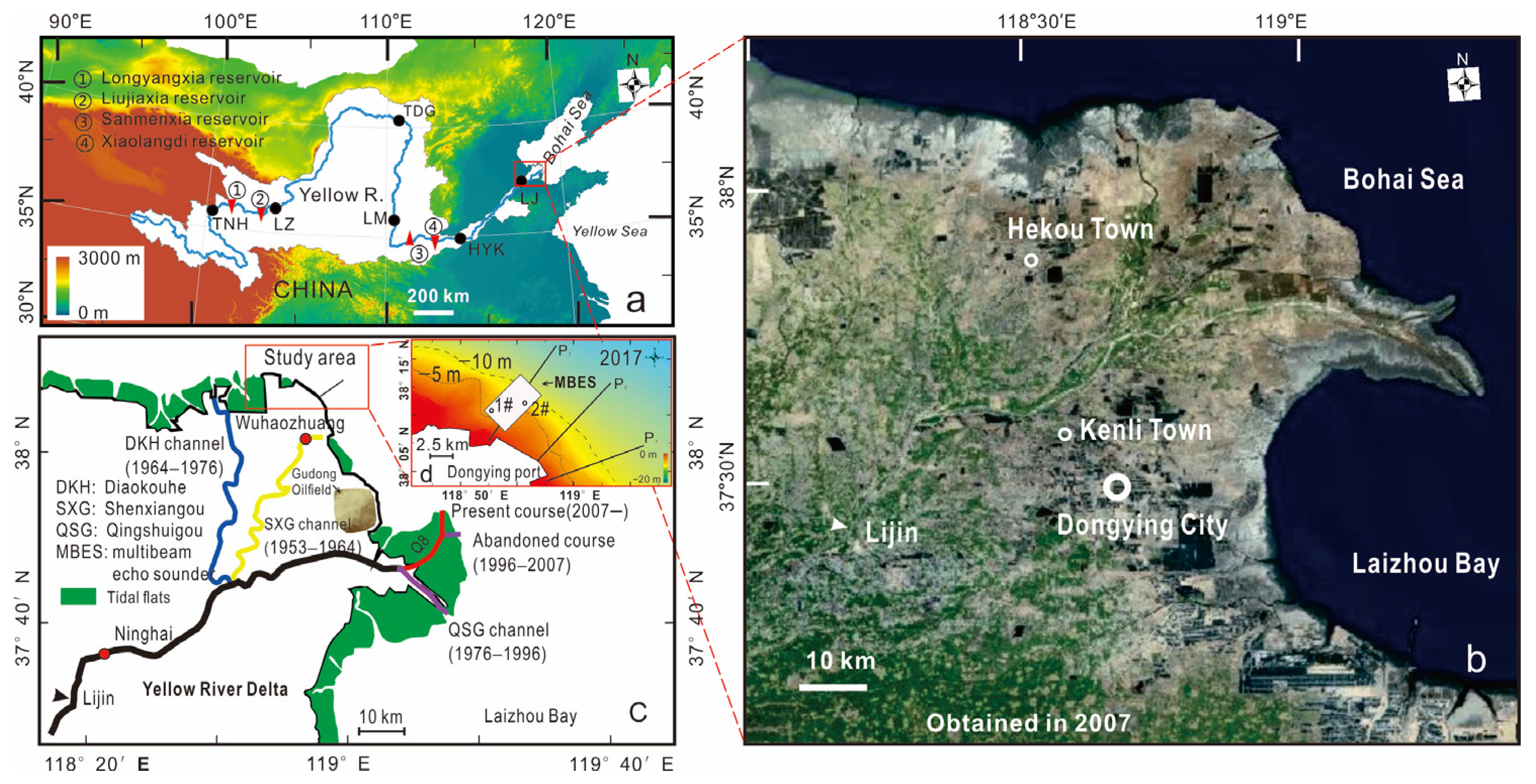
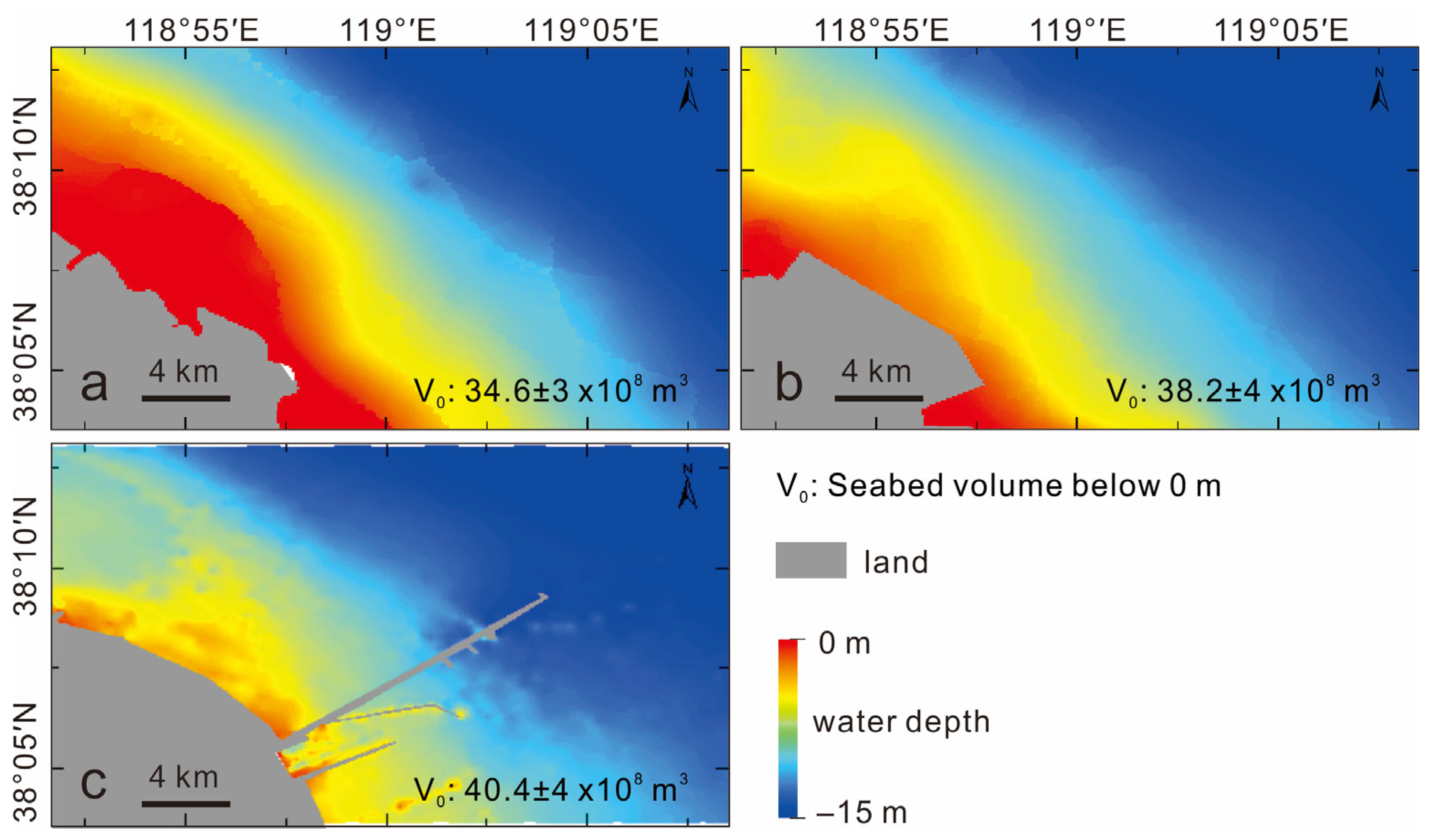
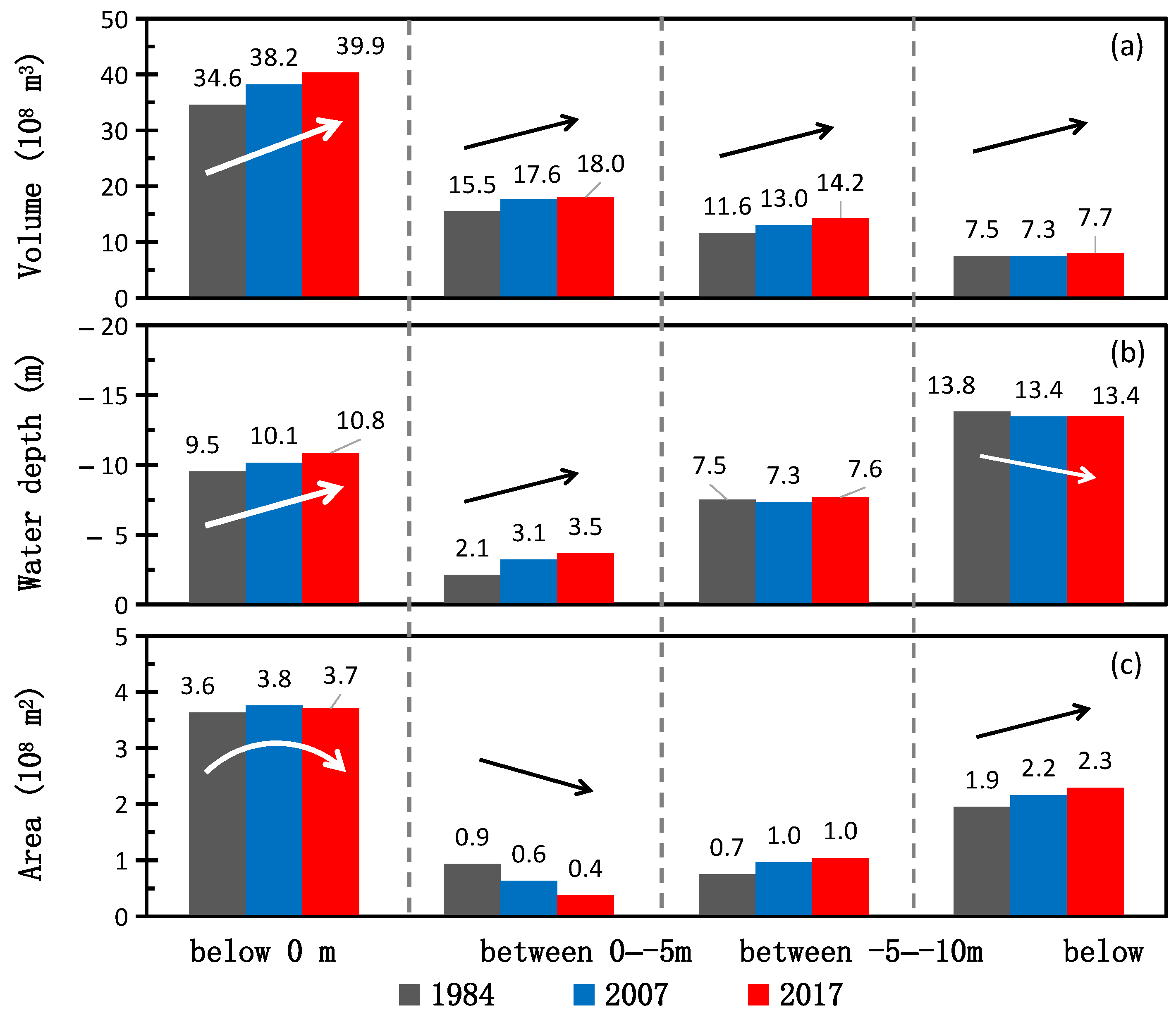
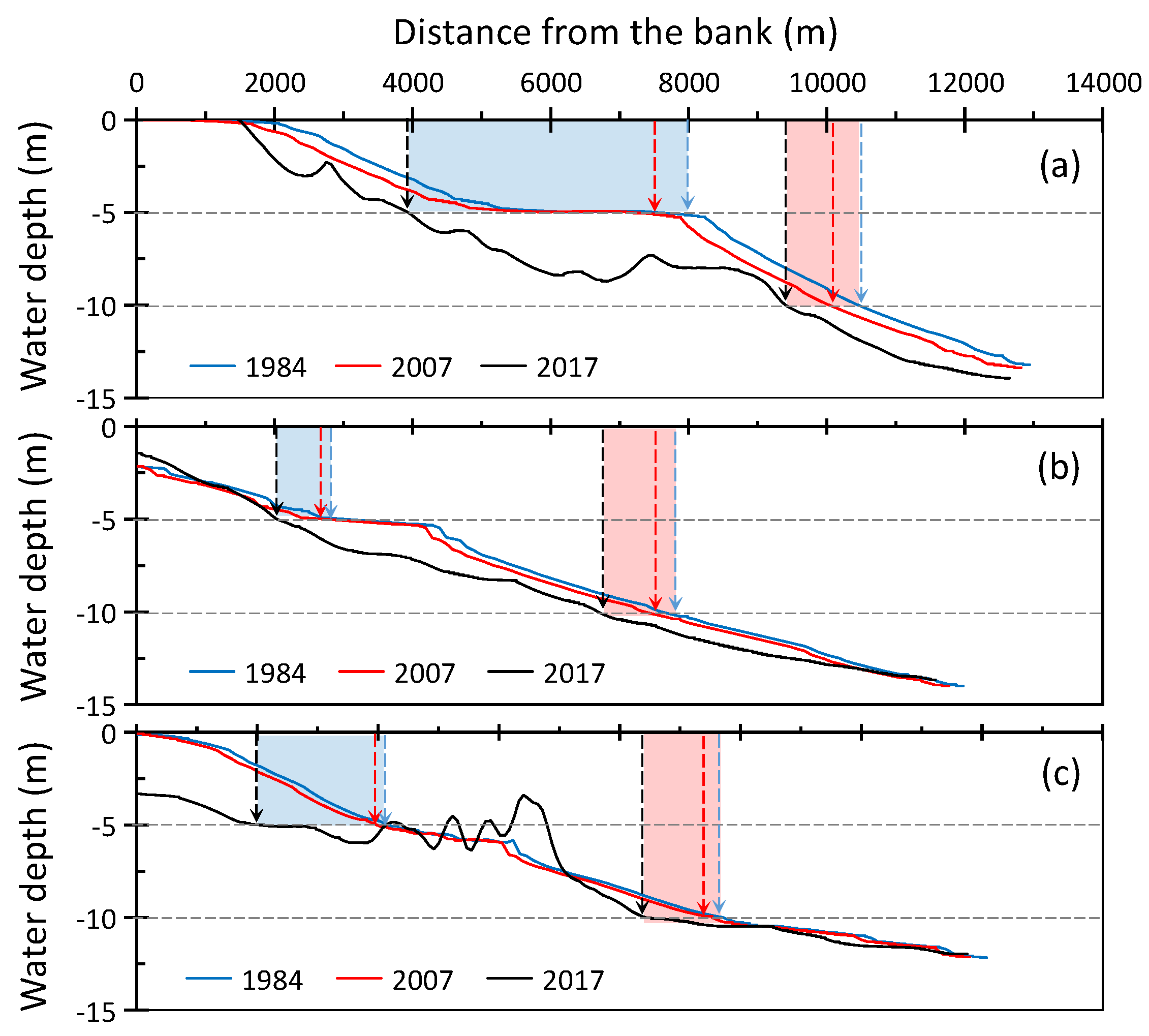
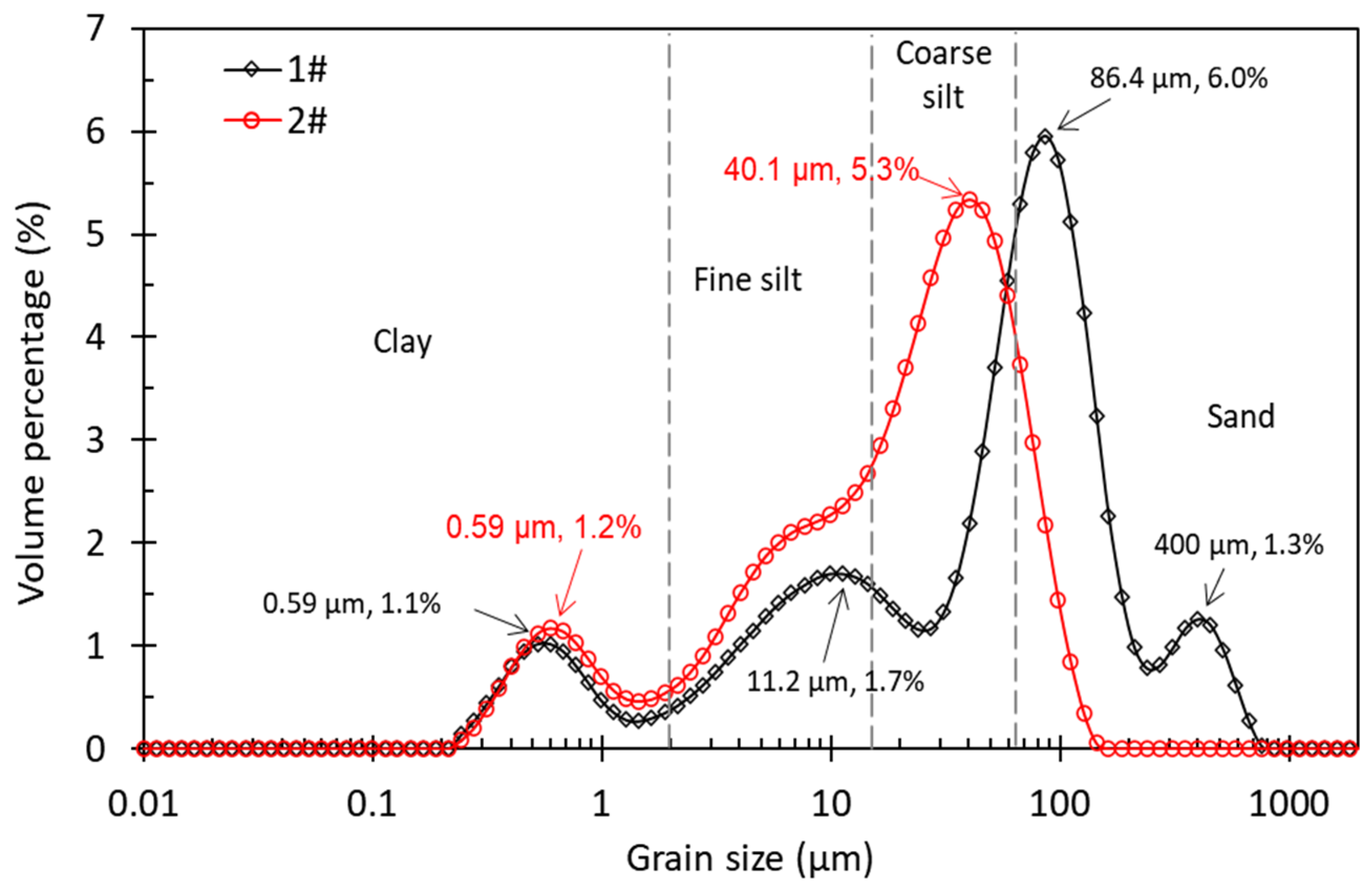
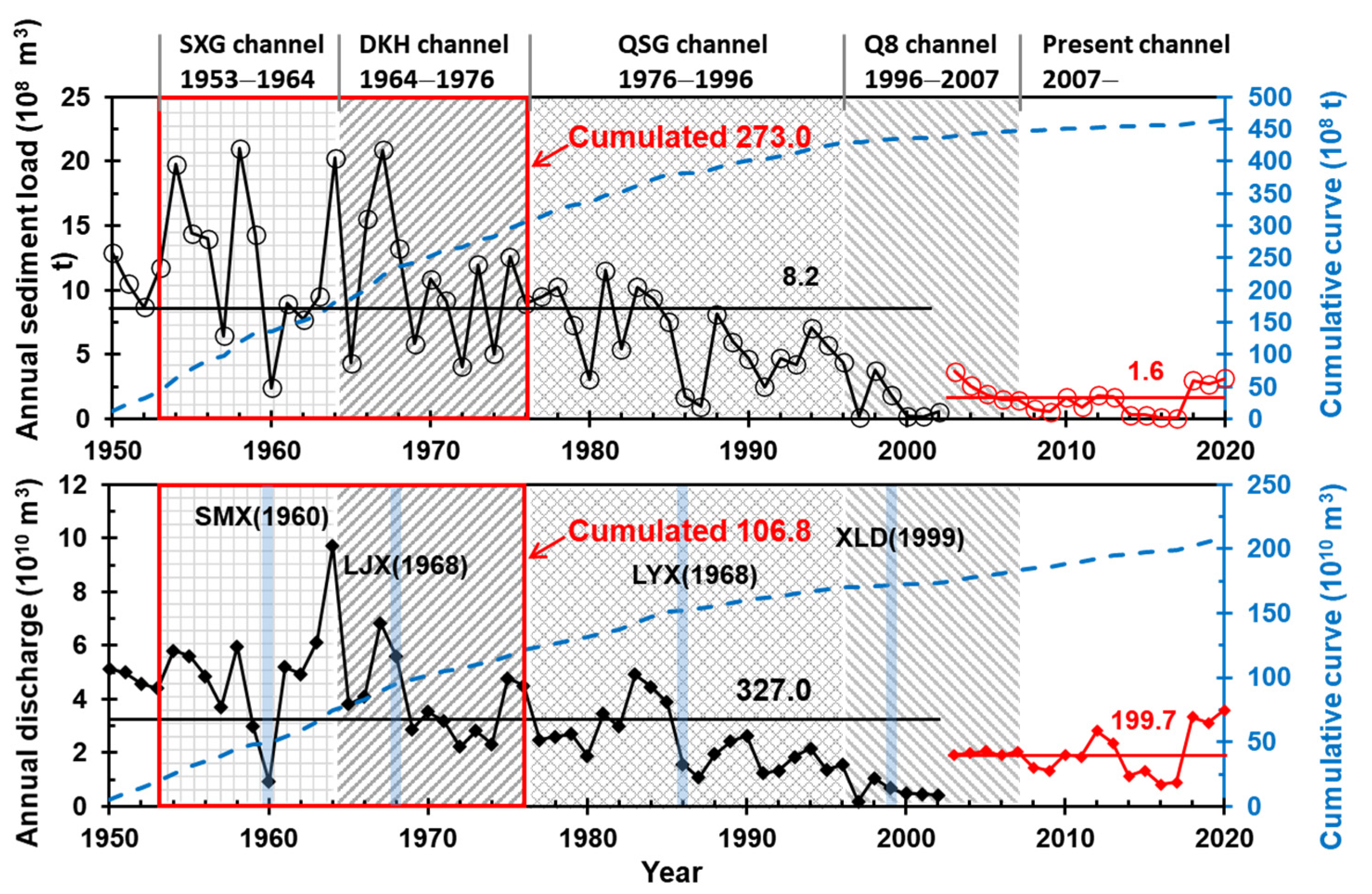
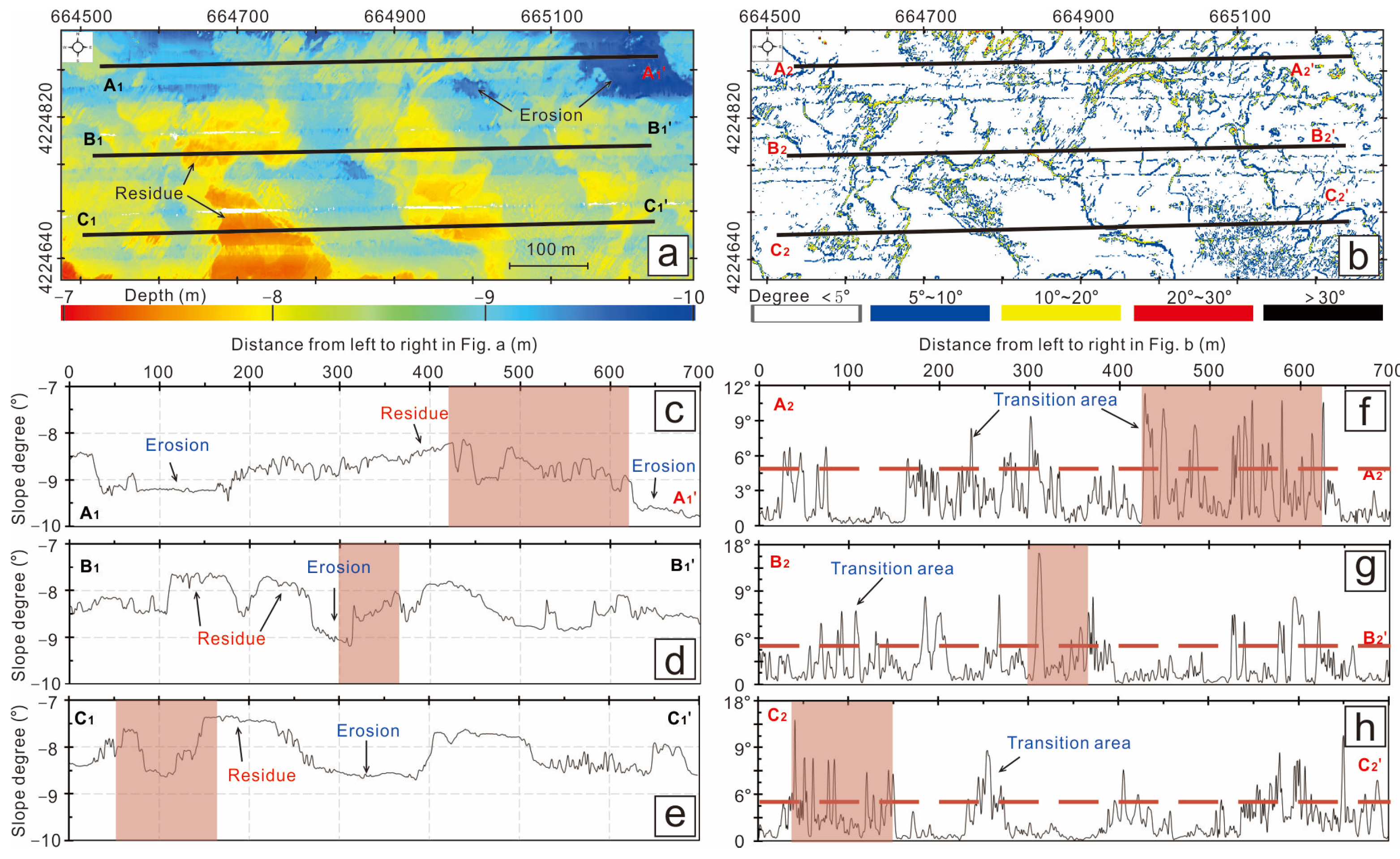
| Number | D50 | Mz | 2 μm | 2–16 μm | 16–63 μm | 63–125 μm | 125–256 μm | >256 μm |
|---|---|---|---|---|---|---|---|---|
| μm | μm | Clay | Fine Silt | Coarse Silt | Fine Sand | Medium Sand | Coarse Sand | |
| 1 | 58.9 | 63.7 | 9.67% | 19.47% | 22.75% | 27.87% | 12.97% | 7.3% |
| 2 | 21.2 | 25.5 | 11.57% | 28.04% | 48.79% | 11.19% | 0.39% | 0% |
| Parameters | Year | From 0 to −5 m | From −5 to −10 m | Below −10 m |
|---|---|---|---|---|
| Annual volume change (×106 m3) | 1984–2007 | 9.33 | 5.87 | −0.7 |
| 2007–2017 | 3.95 | 11.7 | 4.2 | |
| Annual depth change (cm) | 1984–2007 | 4.38 | −1.15 | −1.97 |
| 2007–2017 | 4.21 | 3.15 | −0.14 | |
| Annual area change (×106 m2) | 1984–2007 | −1.31 | 0.95 | 0.92 |
| 2007–2017 | −2.61 | 0.77 | 1.34 |
Disclaimer/Publisher’s Note: The statements, opinions and data contained in all publications are solely those of the individual author(s) and contributor(s) and not of MDPI and/or the editor(s). MDPI and/or the editor(s) disclaim responsibility for any injury to people or property resulting from any ideas, methods, instructions or products referred to in the content. |
© 2023 by the authors. Licensee MDPI, Basel, Switzerland. This article is an open access article distributed under the terms and conditions of the Creative Commons Attribution (CC BY) license (https://creativecommons.org/licenses/by/4.0/).
Share and Cite
Zhang, Y.; Chai, Y.; Hu, C.; Xu, Y.; Zhou, Y.; Chen, H.; Li, Z.; Gang, S.; Zheng, S. Subaqueous Topographic Deformation in Abandoned Delta Lobes—A Case Study in the Yellow River Delta, China. Water 2023, 15, 2050. https://doi.org/10.3390/w15112050
Zhang Y, Chai Y, Hu C, Xu Y, Zhou Y, Chen H, Li Z, Gang S, Zheng S. Subaqueous Topographic Deformation in Abandoned Delta Lobes—A Case Study in the Yellow River Delta, China. Water. 2023; 15(11):2050. https://doi.org/10.3390/w15112050
Chicago/Turabian StyleZhang, Yunfeng, Yingying Chai, Caiping Hu, Yijun Xu, Yuyan Zhou, Huanliang Chen, Zijun Li, Shenting Gang, and Shuwei Zheng. 2023. "Subaqueous Topographic Deformation in Abandoned Delta Lobes—A Case Study in the Yellow River Delta, China" Water 15, no. 11: 2050. https://doi.org/10.3390/w15112050
APA StyleZhang, Y., Chai, Y., Hu, C., Xu, Y., Zhou, Y., Chen, H., Li, Z., Gang, S., & Zheng, S. (2023). Subaqueous Topographic Deformation in Abandoned Delta Lobes—A Case Study in the Yellow River Delta, China. Water, 15(11), 2050. https://doi.org/10.3390/w15112050









